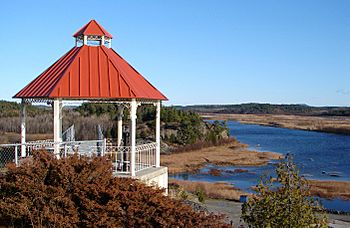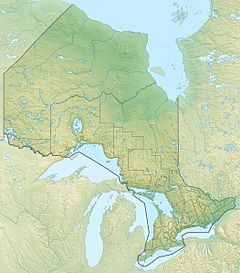Spanish River (Ontario) facts for kids
Quick facts for kids Spanish |
|
|---|---|

Mouth of the Spanish River at the Town of Spanish
|
|
|
Location of the mouth of the Spanish River in Ontario
|
|
| Country | Canada |
| Province | Ontario |
| Physical characteristics | |
| Main source | Biscotasi Lake Unorganized Sudbury, Sudbury District 47°17′40″N 82°00′00″W / 47.29444°N 82.00000°W |
| 2nd source | Alligator Lake Unorganized Sudbury, Sudbury District 47°25′35″N 81°51′54″W / 47.42639°N 81.86500°W |
| River mouth | North Channel (Lake Huron) Spanish, Algoma District 46°11′04″N 82°18′41″W / 46.18444°N 82.31139°W |
| Length | 338 km (210 mi) |
| Basin features | |
| Basin size | 14,000 km2 (5,400 sq mi) |
The Spanish River is a long river in Ontario, Canada. It flows through areas like Algoma District and Sudbury District. The river is about 338 kilometres (210 mi) long. It starts from lakes like Spanish Lake and Duke Lake. It then flows south into the North Channel of Lake Huron, near the town of Spanish.
Most of the Spanish River is in the Sudbury District. However, it also passes through parts of Greater Sudbury and ends in Algoma District.
Many smaller rivers and creeks flow into the Spanish River. Some of these are Pogamasing Creek, Mogo Creek, the Agnes River, the Aux Sables River, the Vermilion River, and the Wakonassin River.
The river's name, and the names of nearby towns like Espanola and Spanish, have an interesting story. French explorers and priests met Ojibwe people in the area who spoke Spanish. This might have happened because a Spanish woman was taken captive during a trip far to the south.
The forests along the Lower Spanish River are very special. They have some of the oldest red pine and white pine trees in the world. Much of this forest is protected by the province as parks.
River History
People have used the Spanish River for travel for thousands of years. First, First Nations people used it. Later, in the 1800s, fur traders used it too.
In the late 1800s and mid-1900s, the river was important for moving timber. Logs from logging camps in Sudbury District were floated down the river. They went all the way to Georgian Bay. From there, tugboats pulled them to sawmills on the Great Lakes.
Until the 1960s, pulpwood (wood for making paper) was sent down the river to a paper mill in Espanola. Large rafts of logs were towed across Agnew Lake. Workers used long poles to guide the logs down special chutes past dams and power plants. This helped the logs reach the mill in Espanola. The sap and bark from these logs used to cause a lot of pollution in the lower part of the river.
In 1910, a dramatic train accident happened on the river. A train derailed at the Canadian Pacific Railway bridge. This bridge was upstream from Espanola and near the High Falls dam.
Modern Use and Protection
Today, the Spanish River is mostly used for fun activities like canoeing. It is protected as a waterway provincial park. Park staff take care of all the park sites and portage routes.
There are four hydroelectric dams on the river. These dams help create electricity. One dam, called Big Eddy, forms Lake Agnew. The High Falls dam is just below Big Eddy. The Nairn Falls dam is about 12 km further down. The last dam is at the Domtar mill in Espanola.



